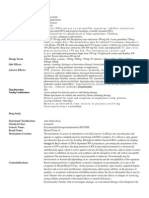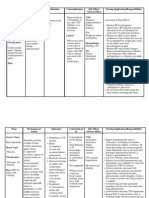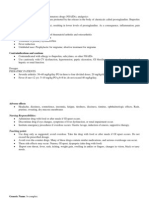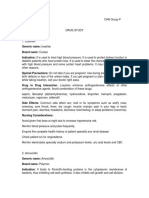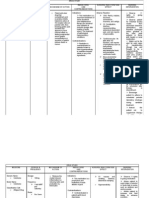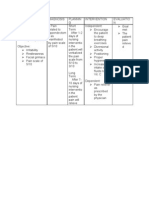Drug Name Classificatio N Mechanis MOF Action Indication Contrain Dication Side Effect Nursing Responsibilities
Drug Name Classificatio N Mechanis MOF Action Indication Contrain Dication Side Effect Nursing Responsibilities
Uploaded by
Princess TinduganCopyright:
Available Formats
Drug Name Classificatio N Mechanis MOF Action Indication Contrain Dication Side Effect Nursing Responsibilities
Drug Name Classificatio N Mechanis MOF Action Indication Contrain Dication Side Effect Nursing Responsibilities
Uploaded by
Princess TinduganOriginal Description:
Original Title
Copyright
Available Formats
Share this document
Did you find this document useful?
Is this content inappropriate?
Copyright:
Available Formats
Drug Name Classificatio N Mechanis MOF Action Indication Contrain Dication Side Effect Nursing Responsibilities
Drug Name Classificatio N Mechanis MOF Action Indication Contrain Dication Side Effect Nursing Responsibilities
Uploaded by
Princess TinduganCopyright:
Available Formats
DRUG NAME
CLASSIFICATIO N
Anti-infectives
MECHANIS M OF ACTION
Tuberculostatic, it suppresses the growth of tubercle bacilli however the specific mechanism of action is unknown.
INDICATION
CONTRAIN DICATION
Patients with optic neuritis. Should generally not be used in children below 6 yrs of age.
SIDE EFFECT
Retrobulbar neurirtis with a reduction in visual acuity, constriction of visual field, central or peripheral scotoma, and green-red color blindness. One or both eyes may be affected. Retinal hemorrhage, skin rashes, pruritus, leucopenia, fever and joint pains.
NURSING RESPONSIBILITIES
Generic Name: ethambutol
Brand Name: Odetol
Ethambutol is used with other antituberculous drugs in the primary treatment of pulmobary and extrapulmonary tuberculosis to suppress emergence of resistance to the other drugs used in the regimens.
Perform visual acuity and color discrimination tests before and during therapy. Assess liver and renal status and function before and during therapy.
Assess patient for visual disturbance t may indicate optic neuritis. Advise patient that compliance with dosage schedule and duration is necessary to eradicate disease.
Dose/ Frequency/ Route
400 mg / tab / OD ORAL
Remind patient to come for follow up consultations including opthalmic appointments.
DRUG NAME
CLASSIFICA TION
Anti-infectives
MECHANISM INDICATION CONTRAINDICATION OF ACTION
Mechanism unknown, highly specific and bactericidal for Mycobacterium tuberculosis hominis. Treatment of active tuberculosis in adults and selected children Acute-liver disease, porphyria, peripheral neuritis, acute gout, hypersensitivity and pregnancy.
SIDE EFFECT
Dose-related hepatoxicity, N/V, anorexia, thrombocytopenia, increased serum iron concentration and adverse effects on blood clotting mechanisms.
NURSING RESPONSIBILITIES
Assess patients condition before therapy and regularly thereafter to monitor drug effectiveness. Monitor serum uric acid which may be elevated and cause gout symptoms. Regularly assess for hepatoxicity. Regularly assess renal status. Instruct patient to take drug continuously as prescribed. Remind patient to comply with follow-up schedule.
Generic Name: pyrazinamide
Brand Name: Mycobak
Dose/ Frequency/ Route
500 mg / 5 ml/ 1 tsp. OD / oral
Name of Drug Generic (Brand) Vitamin B complex
Classification
Mechanism of Action A coenzyme that stimulate metabolic function and is needed for cell replication, hematopoiesis, and nucleoprotein and myelin synthesis.
Specific Indication Pernicious anemia CONTRA: hypersen-sitive to vitamin B12 or cobalt.
Side Effects
Nursing Implications
Vitamins and Minerals
Dose/ Frequency/ Route
1 tsp. / OD / oral
CV: peripheral vascular thrombosis, heart failure. GI: transient diarrhea. Respi: pulmonary edema. Skin: itching, transitory exanthema, urticaria. Other: anaphylaxis, anaphylactoid reactions with parenteral administration, pain or burning at injection site.
BEFORE: Determine reticulocyte count, hct, Vit. B12, iron, folate levels before beginning therapy. Obtain a sensitivity test history before administration Avoid I.V. administration bec. faster systemic elimination will reduce effectiveness of vitamin. DURING: Dont give large doses of vitamin B12 routinely; drug is lost through excretion. Dont mix parenteral preparation in same syringe with other drugs. AFTER: Protect Vit. B12 from light. Dont refrigerate or freeze. Monitor patient for hypokalemia for first 48 hours, as anemia correct itself. Give potassium supplements, as needed.
DRUG NAME
CLASSIFICATION
MECHANISM OF ACTION Inhibits RNA synthesis, decreases tubercle bacilli replication.
INDICATION
CONTRAINDICATION
SIDE EFFECT
NURSING RESPONSIBILITIES Assess laboratory examinations. Monitor liver/renal function. Instruct patient that compliance with dosage schedule for duration is necessary to gain benefits. Caution patient in alcohol while in therapy may increase risk of liver damage. Tell patient to report peripheral neuritis. -
Generic Name: isoniazid
Anti-infectives
Pulmonary and extrapulmonary tuberculosis (TB).
Should not be giver\n to patients with drug induced liver diseas.
Brand Name: Norvit
Various skin eruptions, fever, lymphadenopathy, and vasculitis, hypersensitivity, N/V, GI disturbances, liver dysfunction.
Dose/ Frequency/ Route 200 mg / 1 tsp. OD AC
Name of Drug Generic (Brand) GENERIC NAME: Omeprazole BRAND NAME: Losec (CAN) Antisecretory drug Proton pump inhibitor
Classification
Mechanism of Action Gastric acidpump inhibitor: Suppresses gastric acid secretion by specific inhibition of the hydrogenpotassium ATPase enzyme system at the secretory surface of the gastric parietal cells; blocks the final step of acid production.
Side Effects
Nursing Implications
Antisecretory drug Proton pump inhibitor
Dose/ Frequency/ Route 20 mg / OD / oral
CNS: Headache, dizziness, asthenia, vertigo, insomnia, apathy, anxiety, paresthesias, dream abnormalities Dermatologic: Rash, inflammation, urticaria, pruritus, alopecia, dry skin GI: Diarrhea, abdominal pain, nausea, vomiting, constipation, dry mouth, tongue atrophy Respiratory: URI symptoms, cough, epistaxis Other: Cancer in preclinical studies, back pain, fever .
C: Antisecretory drug; Proton pump inhibitor H: IVTT E: decrease gastric acid secretion C: Take the drug before meals. Report severe headache, worsening of symptoms, fever, chills. K: Swallow the capsules whole; do not chew, open, or crush them.
Name of Drug Generic (Brand) Generic: (Paracetamol)
Classification
Mechanism of Action Cause analgesia by inhibiting CNS prostaglandin synthesis.
Specific Indication Temporary relief of pain and discomfort from headache, fever, cold, flu, minor muscular aches.
Side Effects / Adverse Reaction Hematologic: hemolytic anemia, leukopenia, neutropenia, pancytopenia, thrombocytopenia. Hepatic: liver damage, jaundice Metabolic: hypoglycemia Skin: rash, urticuria
Nursing Implications Advise caregivers to check concentration of liquid preparation. Assess fever, note associated signs (diaphoresis, tachycardia,malaise) Advise caregiver not to take medication longer than 5 days in children Advise caregiver to take medication exactly as directed.
Analgesics ( Non-opioid) Antipyretics
Dose/ Frequency/ Route 5ml q4 PRN if >37.8 C
You might also like
- Gua ShaDocument24 pagesGua Shaprince190067% (9)
- Clinical Medication ListDocument181 pagesClinical Medication Listsophia onu100% (2)
- Naplex Complete Study Outline A Topic-Wise Approach DiabetesFrom EverandNaplex Complete Study Outline A Topic-Wise Approach DiabetesRating: 4 out of 5 stars4/5 (3)
- Modern Techniques in Total Hip Arthroplasty From Primary To ComplexDocument199 pagesModern Techniques in Total Hip Arthroplasty From Primary To Complexdeepak100% (5)
- Project Report OTDocument62 pagesProject Report OTAshish Phadale57% (7)
- Disease Detectives NotesDocument5 pagesDisease Detectives NotesErica Weng0% (1)
- Community Health Nursing Concept II - HandoutsDocument25 pagesCommunity Health Nursing Concept II - HandoutsDherick Rosas100% (1)
- Drug StudyDocument9 pagesDrug Studyjanelee2824No ratings yet
- Additional Pharma CardsDocument21 pagesAdditional Pharma CardsBrilie Karl Viray100% (1)
- 5th Draft DrugsDocument7 pages5th Draft DrugsShayne Jessemae AlmarioNo ratings yet
- Name of Drug Action Indication Contra-Indication Side Effects Nursing ConsiderationsDocument11 pagesName of Drug Action Indication Contra-Indication Side Effects Nursing ConsiderationsMalou SanNo ratings yet
- Drug Name Dose, Route, Frequency Mechanism of Drug Indications Adverse Effects Contraindications Nursing ResponsibilitiesDocument15 pagesDrug Name Dose, Route, Frequency Mechanism of Drug Indications Adverse Effects Contraindications Nursing ResponsibilitiesitsmechachaNo ratings yet
- Drug StudyDocument19 pagesDrug StudyCzarinah Ela MesiasNo ratings yet
- Drug StudyDocument7 pagesDrug StudyDiana Laura LeiNo ratings yet
- Drug StudyDocument70 pagesDrug Studyjahmaicao50% (2)
- Drug Study Case Pres 1Document7 pagesDrug Study Case Pres 1Angelgodess Athena-envyNo ratings yet
- Drug and NCPDocument15 pagesDrug and NCPgeelawliet100% (1)
- CVA Drug StudyDocument51 pagesCVA Drug StudyKarel LuNo ratings yet
- Drug Study - LeptospirosisDocument19 pagesDrug Study - LeptospirosisCamille PinedaNo ratings yet
- Drug StudiesDocument32 pagesDrug StudiesKelly ChanNo ratings yet
- Common MedicationsDocument12 pagesCommon MedicationsJasmeen KaurNo ratings yet
- Name of Drug Classification Action Indication Contraindication Adverse Effects Nursing Responsibilities Ampicillin Sulbactam GI: Diarrhea, NauseaDocument10 pagesName of Drug Classification Action Indication Contraindication Adverse Effects Nursing Responsibilities Ampicillin Sulbactam GI: Diarrhea, NauseaVictor BiñasNo ratings yet
- Drug StudiesDocument16 pagesDrug Studiesvitcloud23100% (2)
- Drugstudy and SoapieDocument17 pagesDrugstudy and SoapieYasi EcheniqueNo ratings yet
- Case Pres PREECLAMPSIA Drugs NCPDocument12 pagesCase Pres PREECLAMPSIA Drugs NCPDanica May Galvez100% (1)
- Drug StudyDocument3 pagesDrug StudyGail SantosNo ratings yet
- Drusadg Study For Paracetamol Omeprazole and Vitamin B ComplexDocument3 pagesDrusadg Study For Paracetamol Omeprazole and Vitamin B ComplexzerpthederpNo ratings yet
- Pott's Drug Study. AdelDocument6 pagesPott's Drug Study. AdelAdelle SmithNo ratings yet
- Drugs Study For PneumoniaDocument5 pagesDrugs Study For PneumoniaLucelle ArellanoNo ratings yet
- Drug StudyDocument11 pagesDrug StudyKaloy KamaoNo ratings yet
- WarfarinDocument10 pagesWarfarinMar Ordanza100% (1)
- Complete Drugs StudyDocument13 pagesComplete Drugs StudyPeace Andong PerochoNo ratings yet
- Drug StudyDocument7 pagesDrug StudyMan GatuankoNo ratings yet
- Drug Study 68-75Document8 pagesDrug Study 68-75joshua_santiago_5No ratings yet
- Cefuroxime Drug AnaDocument4 pagesCefuroxime Drug AnaCarpz DarpzNo ratings yet
- Drug StudyDocument9 pagesDrug Studykcbabee0333% (3)
- KetorolacDocument5 pagesKetorolacMichelle Ann P. NacuaNo ratings yet
- Generic Name Captopril Brand NamesDocument18 pagesGeneric Name Captopril Brand NamesAiko Villacortes100% (1)
- Drug StudyDocument3 pagesDrug Studyanon_11638632No ratings yet
- Drug StudyDocument8 pagesDrug Studysarah1217No ratings yet
- Drug StudyDocument22 pagesDrug StudyColleen Fretzie Laguardia NavarroNo ratings yet
- Clinical Medications WorksheetsDocument2 pagesClinical Medications WorksheetsMichael Kuzbyt0% (1)
- Generic: Acetazolamide Brand: DiamoxDocument33 pagesGeneric: Acetazolamide Brand: DiamoxAshley Topp100% (1)
- Drug Study (AFP)Document10 pagesDrug Study (AFP)Summer SuarezNo ratings yet
- Pharma Cards.Document19 pagesPharma Cards.Brent NicholsNo ratings yet
- Drug Study (Medication Nurse)Document42 pagesDrug Study (Medication Nurse)Ellen Grace CalayNo ratings yet
- ECLAMPSIA Drug StudyDocument10 pagesECLAMPSIA Drug Studyjessica_omegaNo ratings yet
- Ncp&drugstudDocument12 pagesNcp&drugstudSarah Mae Billano BermudezNo ratings yet
- Drug StuyJJASGHDocument7 pagesDrug StuyJJASGHJan Pierre RodriguezNo ratings yet
- Drug StudyDocument24 pagesDrug StudyMc Joewell HudencialNo ratings yet
- Drug Name Drug Class Action Indication Contraindication Adverse Reaction Nursing Responsibility Treatment of Urinary Tract InfectionDocument5 pagesDrug Name Drug Class Action Indication Contraindication Adverse Reaction Nursing Responsibility Treatment of Urinary Tract InfectionOamaga NajlaNo ratings yet
- CHN Drug StudyDocument10 pagesCHN Drug StudyJoshua Cyryll ComiaNo ratings yet
- Jam (Drug Study)Document11 pagesJam (Drug Study)Vincent QuitorianoNo ratings yet
- Drug StudyDocument8 pagesDrug StudyJoel MadjosNo ratings yet
- 13 Drug StudyDocument6 pages13 Drug StudyRachel Yvonne Cabacungan100% (1)
- Drugs Study, Nursing, PreoperativeDocument9 pagesDrugs Study, Nursing, PreoperativeKevin Sam AguirreNo ratings yet
- Drug NameDocument6 pagesDrug NameAnnette Aquino GuevarraNo ratings yet
- ETHAMBUTOLDocument2 pagesETHAMBUTOLXerxes DejitoNo ratings yet
- Drug Study RICUDocument10 pagesDrug Study RICUCee SanchezNo ratings yet
- Pregnancy Risk Category C: Alert: AmoxicillinDocument5 pagesPregnancy Risk Category C: Alert: AmoxicillinNielArmstrongNo ratings yet
- NLM MedicatingDocument11 pagesNLM MedicatingQuimberly ModequilloNo ratings yet
- Drug Analysis (RN) - 3Document9 pagesDrug Analysis (RN) - 3Joannalyn Libo-on0% (1)
- Top 100 Drugs Pocket Reference Guide (2023 Edition)From EverandTop 100 Drugs Pocket Reference Guide (2023 Edition)No ratings yet
- Critical Care Medications: Anti-Arrhythmics Study Guide: Critical Care EssentialsFrom EverandCritical Care Medications: Anti-Arrhythmics Study Guide: Critical Care EssentialsNo ratings yet
- Ncp-Imbalanced Nutrition Less Than Body RequirementsDocument3 pagesNcp-Imbalanced Nutrition Less Than Body RequirementsAllan Maglente63% (8)
- How The Nursing Profession Can Gain Autonomy in The Modern EraDocument13 pagesHow The Nursing Profession Can Gain Autonomy in The Modern EraPrincess TinduganNo ratings yet
- CVA Case StudyDocument20 pagesCVA Case Studybetchai18100% (5)
- Sample - Disciplinary LetterDocument2 pagesSample - Disciplinary LetterPrincess TinduganNo ratings yet
- DS 1Document7 pagesDS 1Princess TinduganNo ratings yet
- Acute Glomerulonephritis Case StudyDocument12 pagesAcute Glomerulonephritis Case StudyPrincess Tindugan100% (1)
- Acute Glomerulonephritis Case StudyDocument12 pagesAcute Glomerulonephritis Case StudyPrincess Tindugan100% (1)
- NDM 1 SuperbugDocument14 pagesNDM 1 SuperbugVinisha Reddy100% (1)
- Physical Education and Health: Quarter 2 - Module 2: Weeks 3-4 Fitness Events ParticipationDocument6 pagesPhysical Education and Health: Quarter 2 - Module 2: Weeks 3-4 Fitness Events ParticipationJasmin AquinoNo ratings yet
- Morrison 1997Document10 pagesMorrison 1997Alexandra MateiNo ratings yet
- Mtendere Community Youth TeamDocument2 pagesMtendere Community Youth TeamReal KezeeNo ratings yet
- NCM 105 Week 1 Part 2Document6 pagesNCM 105 Week 1 Part 2Clint Mikael EulatrizNo ratings yet
- Nurses, Negligence, Malpractice: An Analysis Based On More Than 250 Cases Against NursesDocument10 pagesNurses, Negligence, Malpractice: An Analysis Based On More Than 250 Cases Against NursesLesterNo ratings yet
- Drug Study For OxytocinDocument2 pagesDrug Study For OxytocinAngelica CorpuzNo ratings yet
- Immediate Implant Placement PDFDocument11 pagesImmediate Implant Placement PDFFerdinan PasaribuNo ratings yet
- Pathophysiology Precipitating Factors: Predisposing FactorsDocument2 pagesPathophysiology Precipitating Factors: Predisposing FactorsChristine Pialan SalimbagatNo ratings yet
- Analytical Comparison Between Point of Care Uric Acid Testing MetersDocument3 pagesAnalytical Comparison Between Point of Care Uric Acid Testing MetersAnnisa SufiNo ratings yet
- Bedside Handover SOP PDFDocument20 pagesBedside Handover SOP PDFDewi Ratna Sari100% (1)
- CESU ORD DRAFT EDITED Sent To Dr. AlfieDocument7 pagesCESU ORD DRAFT EDITED Sent To Dr. AlfieDulce TomotorgoNo ratings yet
- NCPDocument2 pagesNCPChatoh SanaoNo ratings yet
- Spravato TaghazoutDocument42 pagesSpravato TaghazoutisaacNo ratings yet
- Effectiveness of Semi-Occluded Vocal Tract Exercises (Sovtes) in Patients With Dysphonia: A Systematic Review and Meta-AnalysisDocument19 pagesEffectiveness of Semi-Occluded Vocal Tract Exercises (Sovtes) in Patients With Dysphonia: A Systematic Review and Meta-AnalysisDANIELA IGNACIA FERNÁNDEZ LEÓNNo ratings yet
- Essay ExampleDocument5 pagesEssay ExampleJonatasPereiraSilvaNo ratings yet
- Pain During Labor and Delivery: ExerciseDocument9 pagesPain During Labor and Delivery: ExerciseLhara Vhaneza CuetoNo ratings yet
- How Germs Cause Disease PDFDocument5 pagesHow Germs Cause Disease PDFI'm a moron.No ratings yet
- Gestational Hypertension and Preeclamsia: ACOG Practice Bulletin Number202 - January 2019Document80 pagesGestational Hypertension and Preeclamsia: ACOG Practice Bulletin Number202 - January 2019Mimmey YeniwNo ratings yet
- Open Fracture Tibia Fibula FixDocument42 pagesOpen Fracture Tibia Fibula Fixannisaoktoviani100% (1)
- Final ScriptDocument4 pagesFinal Scriptjulie calimotNo ratings yet
- LumpectomyDocument24 pagesLumpectomymia rachmi100% (1)
- AAPI Convention Marketing ProspectusDocument12 pagesAAPI Convention Marketing ProspectusAAPI ConventionNo ratings yet
- Parent/ Consent Form: Boy Scouts of The Philippines Sultan Kudarat Council Lutayan District II Boy'S Application FormDocument4 pagesParent/ Consent Form: Boy Scouts of The Philippines Sultan Kudarat Council Lutayan District II Boy'S Application FormEdward Jr. PorrasNo ratings yet
- Personal and Professional ResponsibilitiesDocument9 pagesPersonal and Professional ResponsibilitiesJOHN ANDREW PADILLANo ratings yet














